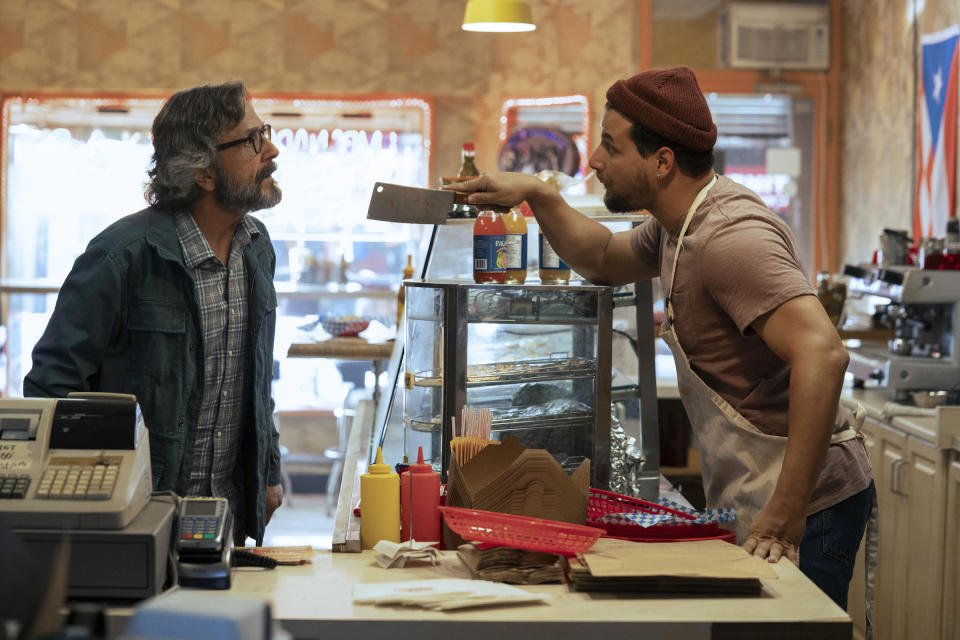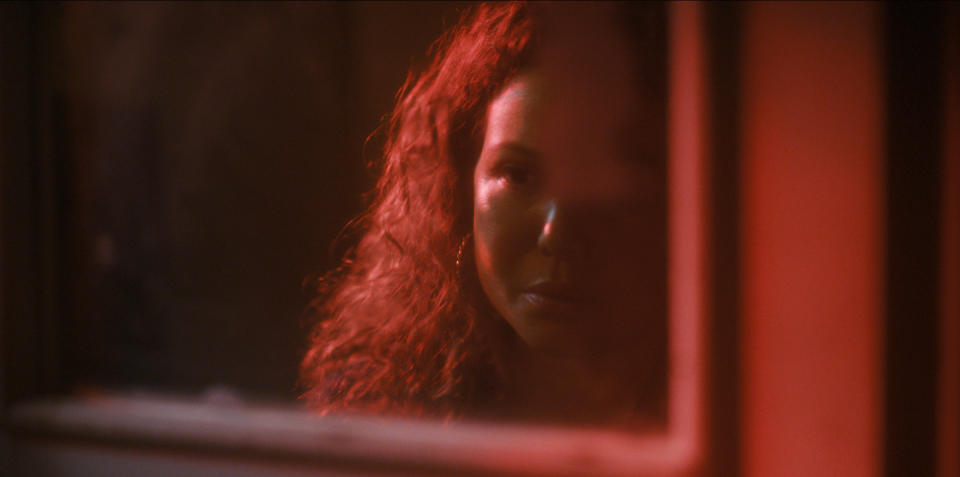How The Horror of Dolores Roach Puts a Twist on Sweeney Todd

Dolores Roach (Justina Machado) shushes Luis (Alejandro Hernandez), the overzealous owner of Empanada Loca. Credit - Courtesy of Prime Video
The idea of cannibalism as a metaphor for gentrification was a lightbulb moment for the writer and director Aaron Mark. Looking around Washington Heights—a historically Dominican area in upper Manhattan—where he lived for 10 years, Mark, a self-described gentrifier, saw such rapid change, it felt like the neighborhood was devouring itself. His next thought was about Sweeney Todd, the play and musical about a barber who slits victims’ throats and a meat pie shop owner who bakes them into pastries.
Along with the actor Daphne Rubin-Vega, Mark took inspiration from the infamous demon barber of Fleet Street to create The Horror of Dolores Roach, a black comedy horror series coming to Prime Video on Friday. Starring Justina Machado in the titular role, Dolores Roach is an adaptation of a 2018 Gimlet Media podcast, written by Mark. The story began as an Off-Broadway one-woman play titled Empanada Loca in 2015, which starred Rubin-Vega, who also voices Dolores in the podcast and worked on the eight-part TV series as an executive producer and writer.
The plot follows Dolores, a former weed dealer who is sent to prison for more than a decade for her crimes, which are non-violent apart from her assaulting a police officer in self-defense during the arrest. When she is released, lost and alone, the only thing that hasn’t changed in a rapidly gentrifying Washington Heights is her favorite empanada place, Empanada Loca. Dolores takes up residence in the shop’s basement and begins work as a masseuse, using skills she learned in prison.
But then, she accidentally-on-purpose kills the landlord (played by Marc Maron), and soon she has killed a few other people—those who figure out the scheme, those who she perceives as harmful, and eventually those who straight-up annoy her. The owner of Empanada Loca, Luis (Alejandro Hernandez), helps her dispose of the bodies in his wares, à la Sweeney Todd’s Mrs. Lovett. As the body count piles up, the cracks in their plan emerge, while a private investigator and the police close in on them.

Cannibalism drives the story in Dolores Roach and Sweeney Todd
The current Broadway musical (starring Josh Groban and Annaleigh Ashford) is a revival of the 1979 production, with music and lyrics by Stephen Sondheim, which won the Tony Award for Best Musical. The character of Sweeney Todd—a British barber jailed unjustly for 15 years who seeks revenge upon his return—first appeared in a Victorian era penny dreadful, The String of Pearls. Penny dreadfuls, popular in the 19th-century United Kingdom, were published in weekly installments of eight to 16 pages. Each one cost a penny, and the serial literature was aimed at the working class. Sweeney Todd, Mark says, has always been social commentary. Some feared the consequences of granting an increasingly literate working class access to fantasies of wealth and adventure.
Over its many iterations, Sweeney Todd has used cannibalism as a narrative tool to explore all kinds of extremes, Mark notes. The musical is about revenge, while the penny dreadful is about greed. In The String of Pearls, the barber is a villain who slits people’s throats to take their money and jewelry. The Horror of Dolores Roach, in turn, is about survival—especially at the margins. The New York City Dolores returns to is one where weed is now on the cusp of legalization; the white moms who have moved to her old neighborhood buy it to help them sleep. Dolores, for context, is Venezuelan, Barbadian, Jewish, German, and Mexican. “I’m from f-ckin’ everywhere, but I don’t belong anywhere,” she says in the podcast.
That line is a favorite of Rubin-Vega’s, who is Panamanian and Barbadian. She has known Mark for about 10 years, when he started writing Empanada Loca with her in mind. Jim Nicola, the former artistic director of New York Theatre Workshop, connected them, and Mark showed up at Rubin-Vega’s doorstep, draft in hand. They sat down on the actor’s floor with coffee and worked through every word together.
Speaking with TIME ahead of Dolores Roach’s TV premiere, Rubin-Vega and Mark considered the topic of cannibalism as it relates to gentrification—and discussed how it all connects to Sweeney Todd.
“It’s not feeding on itself,” Rubin-Vega says of the longtime gentrification in Washington Heights. “It’s being fed on, it’s being preyed upon. We colonize. Isn’t that what we do?”
“It’s less a neighborhood cannibalizing itself; it’s a species cannibalizing itself,” Mark counters. Like, ‘Oh, this is what human beings do: We feed on ourselves.’”

The show’s creators want viewers to take their own interpretations from the tale. Each version of the Sweeney Todd story is its own freestanding Rorschach test, they say, and Dolores Roach is ambiguous about its protagonist’s morality. “People see different things in this,” Mark says. “That extends to the kills themselves: To what degree are the kills justified? Do some kills feel justified and some kills don’t feel justified? To what degree do we forgive Dolores? To what degree do we identify with her behavior?”
“I would love to encourage not needing to come to a conclusion,” Rubin-Vega adds. “Because at least for me, when there’s a show that I love, when I see it again and again, after time, it lands differently. Because I’ve changed. And that’s huge. That’s the reciprocity of art.”
Dolores Roach is the latest in a recent spate of cannibalism content offering a range of social commentary. Chelsea G. Summers’ debut novel A Certain Hunger drew praise for its feminist depiction of the fictional food writer and convicted serial killer Dorothy Daniels, who eats men. Fresh, starring Daisy Edgar-Jones and Sebastian Stan, portrays the rich as literally preying on young women. Bones and All, starring Timothée Chalamet and Taylor Russell, turns cannibalism into an all-consuming love story. Perhaps the most disturbing episode of the post-apocalyptic zombie drama The Last of Us centers not on fungal infections or societal collapse but on a preacher who feeds his congregation human flesh. The second season of Yellowjackets spawned a host of think pieces about what it means for young women to eat one another. Summers, the author of A Certain Hunger, says cannibalism is always symbolic and often a commentary on capitalism.
In art, rarely is cannibalism a sign of pure evil on the part of the perpetrator. Dolores Roach isn’t seeking bleakness or chasing death and demise, says Mark. “She’s looking for life,” he says, noting the irony for a serial killer. “Circumstances have put her in this situation where she finds herself behaving in this way that she doesn’t recognize.”
“She’s a roach for a reason,” adds Rubin-Vega. “Roaches are just like ladybugs, they’re just brown. They don’t have the privilege of being pretty. They have bad press, roaches. ‘An infestation of roaches,’ ‘a loveliness of ladybugs.’ Dolores is a roach, and she’s going to be here long after everyone else.”

